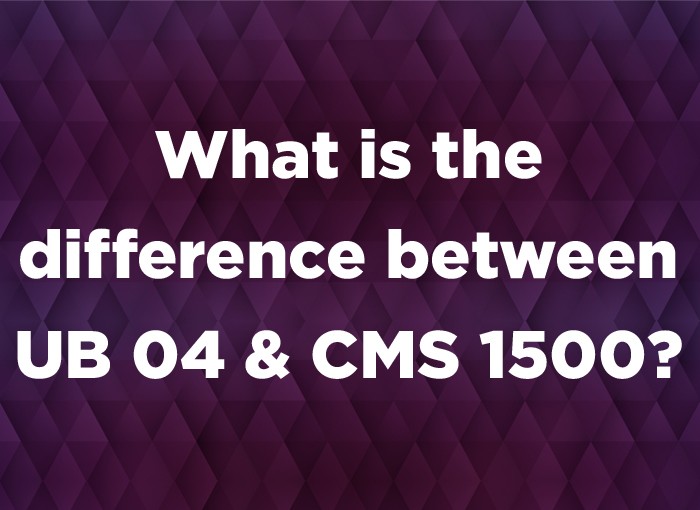What is the Difference between UB04 and CMS 1500
The UB-04 and CMS-1500 forms are designed and maintained by the National Uniform Claim Committee (NUCC). Both of these forms are used for reimbursement purposes but these forms tend to vary in terms of usage.
The UB-04 Form
The term ‘UB’ in the UB-04 stands for Uniform Billing. It is also known as CMS-1450. The UB-92 was replaced by the CMS-1450 form in 2007. The CMS-1450 was developed by the Centers for Medicare and Medicaid Services with the intension to make the billing process both uniform and streamlined. It is therefore, the CMS-1450 serves various purposes by allowing the providers to add all the relevant information to bill the insurance payers. The CMS-1450 form is printed with “red ink” on a standard white paper. The UB-04 is the electronic version of CMS-1450 only.
The Centers of Medicare and Medicaid Services outlines that “the CMS-1450 form can be used by an institutional provider to bill a Medicare fiscal intermediary (FI) when a provider qualifies for a waiver from the Administrative Simplification Compliance Act (ASCA) requirement for electronic submission of claims. It is also used for billing of institutional charges to most Medicaid State Agencies.”
The CMS 1500 Form
The Centers for Medicare and Medicaid Services outlines that “the CMS-1500 form is the standard claim form used by a non-institutional provider or supplier to bill Medicare carriers and durable medical equipment regional carriers (DMERCs) when a provider qualifies for a waiver from the Administrative Simplification Compliance Act (ASCA) requirement for electronic submission of claims. It is also used for billing of some Medicaid State Agencies.”
Why are they Different?
Even though the CMS-1450 form is based on the CMS-1500 form there is a huge difference when it comes to their usage. It is because the hospitals or institutions may not charge for procedures but the physicians do charge for procedures to get compensation. Therefore, CMS-1500 is used by physicians only. However, the institutions where insured patients visit to get treatment are also required to get reimbursement to maintain a healthy revenue cycle. Therefore, such institutions use CMS-1450 form with 81 field locators to provide all the necessary details like HCPCS codes, NPI, Tax ID, etc.
Structure of UB-04 and CMS-1500 Forms
The CMS-1450 consists of 81 fields or form locators called FL that are used to fill specific information. Some of the examples of FL along with the details are as follows:
- FL 1—Billing provider name, street address, city, state, zip, telephone, fax, and country code
- FL 2—Billing provider’s designated Pay—name, address, city, ID
- FL 3—Patient control number and the medical record number for your facility
- Fl 4—Type of bill
- FL 6—Statement from and through dates for the service covered on the claim, in MMDDYY (month, date, and year) format
- FL 81—Taxonomy code and qualifier (the last locator on the form)
The CMS-1500 form consists of 33 items to fill the necessary details for claim purposes. Some of the examples of the items on the CMS-1500 are as following:
- Item 1—Medicare/Medicaid/Tricare/CHAMPVA/Group Health Plan/FECA BLK LUNG/Other
- Item 2—Patient’s name
- Item 3—Patient’s date of birth and Sex
- Item 4—Insured’s name
- Item 5—Patient’s address
- Item 33—Billing provider information and phone number
It is important to note that the CMS-1500 is divided into three parts—carrier block, patient and insured information, and physician or supplier information.



